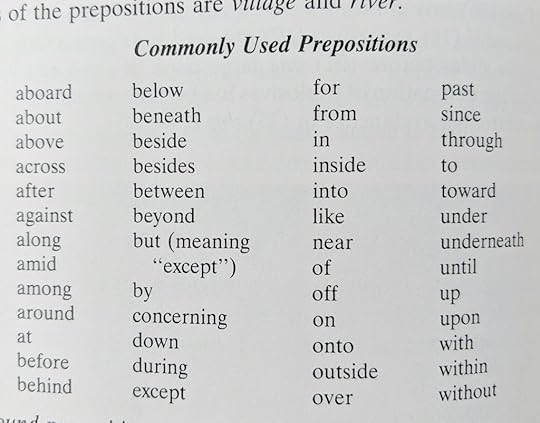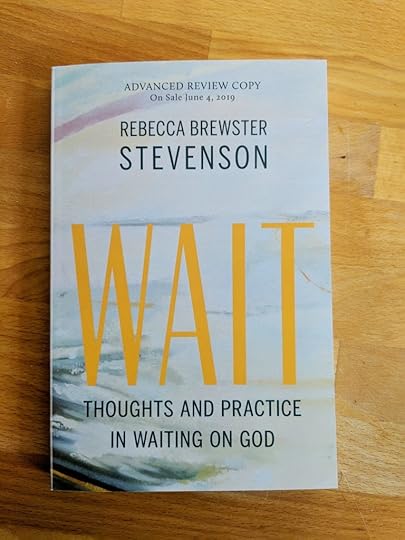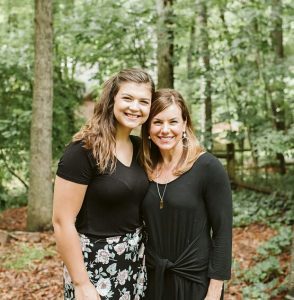Rebecca Brewster Stevenson's Blog: Small Hours, page 3
April 29, 2019
Prepositions, Squirrels, Kettle Bells, and the Subtitle of My Book
Once upon a time, not so very long ago, I taught school.
Er, rather, I taught English. Er, humanities.
Er, students.
I taught humanities (which included English) to students. And I loved it.
Which meant that, occasionally, I got to talk about prepositions. Which I also loved.
Prepositions, you say? Why yes, I say. Prepositions.

***
Prepositions, one of the eight parts of speech, and many of them are among the smallest words in the English language.
How’s that? you say.
Well, here are the most common prepositions, listed in order of size. Note, if you will, how small they are:
to, on, in, of, at, by, for, with, over, across.
The longest of them here is only six letters. Small words. And incredibly important.
Important? you say.
Yes, I say.
The job of a preposition is to connect a noun or pronoun in a sentence to another object in that sentence. In other words, prepositions mark the relationship of one thing to another.
Like so: The squirrel ran up the tree.
Here, the preposition is up, and it shows the relationship between the squirrel and the tree.
Simple, and very important.
How so? you say, because squirrels run up trees all the time. No big deal.
And I sigh and I say Still, and I resist the temptation to tell you that you are reminding me here of some of my more reluctant students.
Instead, I show you how prepositions are important:
Let’s say the squirrel is rabid and you are standing nearby. You don’t want that squirrel anywhere near you (or the young child, say, that you are holding nicely by the hand). In this case, you much prefer the squirrel running up the tree rather than, instead, down the tree, because after the rabid squirrel runs down the tree it might also (it is rabid, after all) run toward you and the young child with the intention of biting you, in which case you must immediately hoist the child into your arms (we haven’t used much in the way of adjectives yet, so we don’t know how heavy the child is) and run helter-skelter for some distance (perhaps) toward Shelter From Squirrels.
More than anything, in that moment, you want that squirrel in that tree. In truth, in that moment, the location of the squirrel is of paramount importance.
But, while we’re at it, let’s revisit that paragraph again, and here I will emphasize all of the prepositions, and you will begin to see how very important prepositions are:
Let’s say the squirrel is rabid and you are standing nearby. You don’t want that squirrel anywhere near you (or the young child, say, that you are holding nicely by the hand). In this case, you much prefer the squirrel running up the tree rather than, instead, down the tree, because after the rabid squirrel runs down the tree it might also (it is rabid, after all) run toward you and the young child with the intention of biting you, in which case you must immediately hoist the child into your arms (we haven’t used much in the way of adjectives yet, so we don’t know how heavy the child is) and run helter-skelter for some distance (perhaps) toward Shelter From Squirrels.
See?
Prepositions are Important.
I know, I know. Why be so dramatic? Are prepositions usually so vital?
Well, okay, but look. Say you left your water bottle at the gym (people are always leaving water bottles at the gym). You want your husband, your friend, your whathaveyou to get it for you, so you say, “My water bottle is on the table,” or “next to the kettle bells,” or “under the bench.” You may have given your kind person a description of your water bottle, but telling him or her where that water bottle is makes fetching it for you far simpler and faster. Enter prepositions.
And in another entirely different example, consider the difference between prepositions in the following sentences:
He walked through the water to rescue me.
He walked on the water to rescue me.
In the latter sentence, the he might be someone Entirely Different from the he in the former.
See? Prepositions.

***
But (and you knew that was coming. Did you know that was coming?), prepositions can also be murky. The examples I’ve provided thus far make them oh, so clear, but we use them, too, to show relationships in the abstract.
Take, for example, the title and subtitle of my new book: Wait: Thoughts and Practice in Waiting on God.
We have two prepositions here. Do you see them? Thoughts and Practice in Waiting on God.
Why is it “in”? Why not “for”? The book is about that. It’s about some thinking and understanding for those times when one is waiting on God. And it’s about things one can do when one is waiting on God. So “for” would work nicely here.
Or we could go another route. Skip the preposition entirely and throw in “while,” and now we have a conjunction that means “during the time that.” Thoughts and Practice While Waiting on God. Perfectly applicable.
The thing is that, while prepositions can be very helpful in communicating the specific, they can also make space for generalities. They can suggest the idea of a relationship without assigning one.
In the subtitle of my book, the in functions as a preposition, and it says what it means to: here, in this book, are some thoughts and some practices related to, helpful for, significant regarding waiting on God.
In short, my publisher chose the preposition in, and it works just fine.
***
It’s the latter preposition in the book’s subtitle that is of real interest to me. Waiting on God. Waiting on God. In light of what I said earlier regarding prepositions (that they “mark the relationship of one thing to another”), it’s this piece of the book’s subtitle that really matters.
It’s one thing (and nothing like uncommon) to be dissatisfied, to be in want or need. To be hoping and longing for a change, a thing to come about, a shift in one’s life from one kind of status to another.
But if, within that dissatisfaction, one knows of One who can fix it, a God who could–if he wanted to–snap his fingers and bring baby, spouse, job, health, whatever-one-longs-for–into the picture…. If one is waiting on God, then that dissatisfaction shifts and becomes part of a relationship.
My husband and I–and our dear children–have been waiting on God for a very long time. Almost eighteen years, in fact. In that span we have been very happy and we have also (at times) been desperate. But because we have been waiting on God, we have also had tremendous hope.
It’s that prepositional phrase –that Waiting on God bit– that is the whole reason for the book.
So Much Hope.
I do hope you already know the hope I am talking about. If not, please know that the hope can be yours, too, no matter what you’re waiting for.
And I hope that, when the book comes out (June 4!!) you will read it.
Below, find Ways To Get This Book. And thank you.

Sign up and pledge-to-buy.
Pre-order on Indie-Bound.
Pre-order on Amazon.
Pre-order on Barnes and Noble.
Pre-order on Kobo.
The post Prepositions, Squirrels, Kettle Bells, and the Subtitle of My Book appeared first on Rebecca Brewster Stevenson.
April 18, 2019
Disaster and Redemption
Last Wednesday when I drove Emma to school, the pollen hung in the air like a scrim. It comes every year: two weeks of early spring in which our world is silted with a gritty yellow dust. It coats railings and window sills; it clings to cars, dusts the newborn leaves, and pools in untouched corners of porch and parking lot.
 Photo credit Lynne, who is enjoying her first spring in North Carolina’s piedmont.
Photo credit Lynne, who is enjoying her first spring in North Carolina’s piedmont.You can garden in it, and plumes of the stuff will rise with every leaf you disturb. You can run in it, and it will stick to your sweat and fill your mouth and eyes with grit.
There’s nothing for it but to wait it out. Even rain brings little relief. While we may watch this yellow dust running down the drain, it returns on the next dry day. The trees will release this pollen–filling our air and lungs, dusting our skin with its reproductive hopes–until it has run its course.
***
And Wednesday was the day that Emma called me from school. She called; she didn’t text. A text from Emma is not uncommon during the school day: a message to remind me of something, or to tell me how she is, or to ask me to remind her of something–at which I will scrawl the message in Sharpie on a piece of paper and tape it to a kitchen cabinet.
But on Wednesday, she called, which meant something was wrong. And when I heard her voice, it matched mine in an emergency: hushed, slow, measured.
“Mom. I’m okay. But there’s been an explosion.”
Amazing the thoughts that pour into the milliseconds between a phone’s ring and the voice that answers, “Hello?” And in the next milliseconds between the reassurance and the explanation for it all.
I think we all think about it at the drop-off, right? We’ve seen it too many times on the news, and in my teaching days I supervised my classroom in the drill: the lockdown, the silence, the students’ bodies folded and pressed into the space least visible from the door.
Lord, have mercy.
Last Wednesday it was not a shooter but an explosion: the coffee shop we drive past nearly every day. The oasis we’ve visited many times in its sun-filled mornings with its ancient and beautiful black-and-white-tiled floor. It was a gas leak, and now everything is gone–and with it, the owner–less than a block from Emma’s school.
***
The school handled it very well. The early release was executed promptly, counselors were present. The necessary cancellations and then two-hour delay were clearly communicated. And yesterday, the students wore white in a show of support to all affected by the explosion, and most specifically to honor Mr. Lee, who lost his life.
***
Then on Monday, I had a text from Emma: “Mom, Notre Dame is on fire.”
She hasn’t seen the cathedral in person yet, but we have long hoped to take her there.
“Crazy how many things are catching fire,” she wrote.
And interesting how fire ignites fire, how we see the connections even when they aren’t connected. How disaster here and disaster there are linked in our minds. Trauma, we know, can do this to us: an accident fifteen years ago can somehow still startle us today if the sound is loud enough.
The coffee shop exploded, and to Emma–who, while in the school was literally about as far from the explosion as she could possibly be–it sounded like someone immediately next to her pounding and banging on a metal door.
***
We can’t drive past the front of the coffee shop yet. That section of Duke Street is closed. But I drove near it yesterday to get Emma.
The building is gone, replaced by light and rubble. But the light is wrong: it shouldn’t be there. Wrong, too, are the collapsed roof and wreckage, the blasted out windows of the surrounding buildings, and the dark marks around these empty spaces where flame, debris and smoke shot through and stunned us all.
***
Which brings us to last Wednesday’s pollen and this week’s clear sky where, now, the scrim has lifted. Even last Thursday it seemed the pollen was on its way out. And Friday evening’s thunderstorm scrubbed the last of it away.
Somehow this brings to mind that now famous saying of Mr. Rogers, whose own mother, helping her young son contend with the horror of disaster, told him to always look for the helpers.
Look for the helpers: and there they were, evacuating the coffee shop before the explosion, and afterward carefully picking through the debris. Some continue to channel traffic around the site; others took pains to confirm the stability of the school buildings before students were allowed to return.
See, too, the counselors, present and ready for students affected by the trauma. And the students themselves, yesterday tying white ribbons to the school’s fence in honor of Mr. Lee.
In Paris, over 400 firefighters worked tirelessly to put out a blaze that, for a time, they said could not be overcome. Others pulled priceless works of art out of harm’s way. And across the river, grief-stricken Parisians watched the flames and prayed, a vigil against utter destruction.
***
Sometimes it’s easy to feel that loss and disaster are the way of things. We can far too readily count the corrosive forces of the world.
But the helpers are world’s redemptive motion, as are those who grieve a loss not explicitly their own.
And this motion–do you see it?– runs deeper than human will. Recall the pollen, already finished for the year. It coated our world for two short weeks, a nuisance of yellow dust. It was a gesture toward continuance, the opened palm of life’s Author, an elaborate if gritty abundance of hope.
***
Daisy, why another day?
Why another sunrise?
Who will take the blame
for all redemptive motion
And every rainy day
When He gives Himself away?
–“Daisy,” Switchfoot

The post Disaster and Redemption appeared first on Rebecca Brewster Stevenson.
January 5, 2019
Turning the Page
 Everett came into the kitchen yesterday and said, “I’m sad Christmas is over.”
Everett came into the kitchen yesterday and said, “I’m sad Christmas is over.”
And it is. Suddenly. Our tree is still up, some decorations still out, but Everett is right. Everyone is back to work or school, and yesterday my parents went on their way. So now–for real and for true–we seemed to have turned the page to January.
And yet, one street away from us, neighbors have pumpkins on their front steps: three of the standard orange and one white and squat.
I get it. I absolutely do. For me, 2018 flew by, and the months between the autumn and winter holidays were like something out of L’Engle’s tesseract: for all I know, someone took the corner of October first and bent it right into December and voila! Christmas is over and Everett’s birthday, too, and we’ve celebrated the New Year to boot. Spit spot! (That’s Mary Poppins).
As we drove past the pumpkin neighbors, Bill (who will be taking down our outdoor Christmas decorations this afternoon) explained it to me. “We don’t get any practice for this,” he said. “Between October and December we have so much to decorate for, but for the rest of the year, no one cares.” He’s right. You can have anything–or nothing–decorating your front steps the rest of the year. But come September it’s pumpkins or nothing, and within weeks, pumpkins are all wrong.
Not that anyone’s judging.
I’m certainly not. I feel like the last three months of the year are a bit of a scramble for lots of reasons. First of all, I am not a good plan-ahead gal. I know lots of people who do their Christmas shopping year round, people who write out menus and buy ingredients in November (because they’re on sale) for things they’ll bake the next month. I have nothing but admiration for them.
But (and despite being a mother for over twenty years), I feel like I’m just beginning to learn that Christmas and the other holidays are actually annual events, and I have no excuse but to be better prepared. At the very least, I would be wise to spread the shopping out over the last several months of the year.
 The truth is more fundamental, though: I’m just not a special events kind of person. That isn’t to say I don’t love them: I do. But event planning is not my thing on lots of levels. I thrive in the everyday, in the routine and normalcy that give me room to think, and in the slower rhythms that allow for emotional quiet. Those are the spaces that allow me to write.
The truth is more fundamental, though: I’m just not a special events kind of person. That isn’t to say I don’t love them: I do. But event planning is not my thing on lots of levels. I thrive in the everyday, in the routine and normalcy that give me room to think, and in the slower rhythms that allow for emotional quiet. Those are the spaces that allow me to write.
Boring. So boring.
I know.
So here we are in January, and Everett may be sad about it, but I’m not. I’ll take the new calendar, all blank squares and black lines. I’ll take the swept front steps, too. And I’ll take (yes, please) the empty trees, their trunks and branches limned in sunlight, and the sound the wind makes as it rushes through them.
My grandmother taught me to love the empty trees. “When they’ve lost their leaves,” she would say, “we can see their shapes.”
There’s much to be said for the shape of a tree. And there’s much to be said for clear eyes and clean views and, yes, fresh beginnings.
Welcome, January. I’ll take your openness and your emptiness: all of that quiet possibility.

The post Turning the Page appeared first on Rebecca Brewster Stevenson.
January 3, 2019
Something Old for the New Year
Hi Friends! and Happy 2019!
While it is already January 3rd, we are not quite through the holidays at our house: my parents are still with us, and so I refuse to return to normal life.
But I thought I’d throw a little something out on this here website of mine, something that reflects where my mind–in those rare, idle moments of these holidays–allows me to go.
And where does it go, you may be asking (or maybe not, but I’ve led us that way, so here goes)? My mind moves ahead to what 2019 will be bringing: the wedding of our second-born, and the high-school graduation of our third-born, and the anticipated and inevitable emptying of our nest.
I have more thoughts on this (are we surprised?) but will leave them for now. My parents are here, and I want to spend more time with them. Instead, I will offer you this from another year, a Christmas that, in practice, was not all that different from this year, except that Emma was four-and-a-half, and we went to Pennsylvania and Bill’s parents for the holidays.
Emma Sleeps

These are not ordinary days, these Christmas ones, these holidays. These days we are eating too much, and lazing around, visiting with family and friends we haven’t seen in too long, and staying up too late. We are away from home now, and we are gone home to western Pennsylvania with Bill’s family. The children love it here, not just for the snow which, sadly, is melting fast anyway. The children love it for their grandparents and the joy that comes with being with them. It is good to be here.
One of my earliest memories is the sound of my grandfather sipping his morning coffee where he sat in the lazy-boy of his living room. From my bed at his house I could hear this, and I would go creeping down the stairs to be greeted with joy by both my grandparents, greeted with almost unreasonable joy: we were only just starting another ordinary day, after all.
My grandfather loved to remember a story of me on an ordinary morning like that, a morning I remember well. How old was I– six? I came down the stairs and climbed into his lap, laid my head on his shoulder and closed my eyes. I stayed there like that with him for a long time, half-listening to him sip his coffee and simply breathe, half-hearing him tell my mother and grandmother that yes, indeed, I had gone back to sleep.
I had not gone back to sleep, but I stayed there, comforted, for a long time. And afterward I loved to hear him remember it, his eyes almost closed by his smile and the pleasure of the memory. I don’t remember if I ever told him that I hadn’t slept at all.
But these are not ordinary days, these Christmas ones. Christmas can make Emma sleepy, particularly if we leave the house at 5:30 in the morning for our big trip, particularly if the seldom-seen cousin arrives at 10:30 at night, particularly if she doesn’t go to bed until after mid-night, regardless of Santa Claus.
She was so sleepy that she fell asleep on my lap during mass last night just as the priest was beginning the homily. I could tell that Something would have to happen: she was just far too squirmy to make it through the service without a Serious Scolding. She sat on Bill’s lap, she sat on mine. She tried to climb on the kneeler; she tried to climb on the hymn-shelf; she made a Big Hole in her tights. Trying not to sound horrified, I told her that she Must Sit Still and Say Nothing. Within minutes she had folded herself sideways, her head on my knee. I stroked her hands and traced her fingers; I stroked her hair where it fell over her forehead and my skirt.
It wasn’t long before I realized that she had been still for a long time– a Long Time for someone who is four and has only recently been climbing the pew-back. I looked and saw her eyelashes lying on her cheeks; I saw her fingers relaxed and still against her leg; I knew she was asleep.
There is a good deal of wonderful and significant standing, sitting and kneeling in a Catholic mass. I missed it all but the sitting, enjoying her slumber and its privilege falling on me. I listened to the reading of Luke 2; I sang the hymns from the missal; I was moved again– again– by the reminder of the abject humility of Christmas, what Annie Dillard calls “God’s emptying himself into man.”
I felt nothing like empty, my arms and lap full of the weight of my sleeping daughter.
The children were awake alarmingly early this morning, considering how late their rest began last night. And although Emma Grace was the last to wake, she warned me of a Need to Nap only halfway through the gift-opening. After a bath, after brunch, she curled up with both brothers and Granddad and was still there an hour later, sleeping fast, the only one in the bed.
I let her sleep for that hour, then went in to get her. The need for sleep at her age is an awkward thing to balance: too much sleep now means no chance of it later, and then we begin the cranky cycle all over again. So I pulled her from the bed and carried her to the living room where I was visiting with family, hoping all the while to coax her from her dreams.
I didn’t try very hard. Although she is tall for her age, Emma Grace’s little body still fits warmly in my lap. Her yellow hair smelled so good from the bath; her even breathing contented me. She sucked her thumb and, as she always has, let her fingers spread themselves out over her nose and eyelids. Then her thumb fell from her mouth, her head tilted up, and I looked into her still-sleeping face, watched her lashes rest on her cheeks, watched her little mouth open like a flower.
I held her for nearly an hour, maybe more. The time felt like nothing, and the afternoon was nothing like ordinary, Christmas or no. I sat there with my daughter filling my lap and thought of my grandfather, his eyes creased with joy at the memory of holding me.
The post Something Old for the New Year appeared first on Rebecca Brewster Stevenson.
December 1, 2018
Advent 2018

Advent, the four weeks in the church calendar leading to Christmas Day, begins on Sunday, December 2 this year.
I’ve written four reflections, one for each week of Advent, to help us consider how we might respond to the birth of Jesus.
Click here to download the readings, and may new understanding of the Christ-child make your Christmas truly Merry!
__________
The post Advent 2018 appeared first on Rebecca Brewster Stevenson.
November 14, 2018
Fist Full of Sparrows
 Our backyard maples are skeletal now. It happened in that sudden way that means I haven’t been paying attention.
Our backyard maples are skeletal now. It happened in that sudden way that means I haven’t been paying attention.
I know they flushed to gold about two weeks ago. Emma called me to the window, and we stared at them together for a minute. They can seem incandescent in those early yellow days, like we don’t really need to turn the lights on inside at dusk.
I may have seen a leaf or two take a turn downward. There was that day I worked at the kitchen table and watched so many drifting free. Some of them sailed, some turned in tight circles. One I watched fall and catch itself on a lower branch.
And now today these trees are mostly empty.
***
Today, too, is word of loss. 48 dead in the California Camp Fire. This was the news that woke me this morning on my radio alarm.
On Sunday during our worship service, phone alarms from around the congregation reminded Bill and me of the alarm we too had received that morning: another Amber alert. A child taken, and a parent–unknown to us–inconsolable.
And last night, news analysis about pressure potentially brought to bear on Saudi Arabia: the chance that the kingdom could relieve the crisis of famine in Yemen.
***
I don’t begin to know how to pray for these things–and prayer seems ineffectual. But I can do nothing about the forest fire. I am powerless for the stolen child. Yemen’s distress grieves me–but also, for now, anyway–I cannot help.
***
I think He saw the leaves fall. Sees them fall. Saw with me the one cut loose then drift to resting on a lower branch.
So too He says He sees the sparrow–that small and unconsidered life. During the life of Christ on earth, two sparrows made the cheapest meal. A solid source of protein for less than an hour’s wage.
If He knows the death of the sparrow, how much more the life of the one who must eat it? Child. Woman. Man. Person. Image of God.
***
So I do pray for Yemen. For California. For the stolen child and her mother. I hold them up to him–fist full of sparrows. Lord, have mercy.
***
“Are not two sparrows sold for a penny? And not one of them will fall to the ground apart from your Father.” Matthew 10: 29
“Once God has spoken; twice have I heard this: that power belongs to God, and that to you, O Lord, belongs steadfast love.” Psalm 62: 11
The post Fist Full of Sparrows appeared first on Rebecca Brewster Stevenson.
November 12, 2018
Observed at a Restaurant off Fremont Street

We arrive relieved and a little breathless from the din. We almost didn’t find it; I had considered giving up.
But there it is on 6th Street, just past the tortilla place. Here is something different from the rest of Las Vegas: low ceiling, warm light, a host who enjoys the word “patio.”
He invites us to sit inside, in that low, warm room, or upstairs on the rooftop patio. But it’s “patioooo,” he says, drawing out the “o” because he likes patios or the “o” sound, or because he thinks the patio is where we should sit. And we do.
On that rooftop, the ceiling is all string-lights. Somewhere above them hangs the neon haze of Las Vegas. And above that, presumably, are stars, night sky, ascendant heavens, even (rumored) planets. A satellite blinking along.
But we are grounded at a table for two. And near us, a merry crowd is moored around three tables pressed together.
Theirs is a meal at its close: plates scraped clean, napkins wrung out and exhausted on table-top or under chairs. Wine bottles empty and glasses going that way. Six adults in Las Vegas, but without that glaze-eyed-look. They are laughing, leaning in, bright like string-lights.
And we are talking to our host about the menu, about the restaurant, about nearby Fremont Street and this refuge of warm wood and a menu drawn up by hand.
Then the host calls him over: the young man seated on the corner of the pressed-together tables. He stands, and I see the apron at his waist. He is one of their chefs.
He might be twenty-two. Maybe twenty-four, at the most.

We talk with him for a few minutes. Where he is from, how he came to be here. How he likes living in Vegas, how he likes working here. And they, he tells us, turning his chin toward his shoulder, are his family. Some of them live in town, but that one is his mother, just come to visit, he says, to see him at his new job. She’s going home tomorrow morning, early. It’s been a good visit.
He leaves us, rejoins his family, and Bill and I are happy to retreat to ourselves, anticipating the menu’s implications. I have ordered the salmon; Bill is getting the steak. Our host has insisted on the macaroni and cheese: it’s a family recipe and he is from Wisconsin. But first we enjoy the tempura green beans served with the brilliant miracle they call pepper jelly cream cheese.
From where I sit, dipping beans in cream cheese, Fremont Street’s panic seems almost impossible. The strobe lights, the neon; the girl in glittering bikini turning twenty hula hoops on her waist; the ring and clatter of the slot machines–all of it has dissolved under these lights. Here we have a friendly chef, a kind server, a host who likes words, green beans.
The chef’s family has left their table. They are disbanding, each taking a turn with the young chef in an embrace, a handshake. They move toward the stairs, but I’m not watching them: my salmon has arrived and I am taken with it, with its puree of spinach, with the way salmon breaks and folds so easily in the mouth. And Bill and I are having our Las-Vegas conversation, our wheat-and-chaff conversation, our practice of looking for beauty where much is not beautiful.
That’s when I see her: the chef’s mother, descending the stairs. She is with someone–her sister, perhaps–and that someone is turned toward her, talking. But I watch this mother, who can’t be that much older than I. She is listening to the one speaking to her, but watching her son as she descends the stairs, hoping, I would think, to catch his eye.
She leaves tomorrow early. She won’t see him again this visit. He is talking with a server, his apron hanging at his waist, hands on his hips. He has already said goodbye.
But still I think of her descending, watching her boy, holding–as she can’t help it–those things she knows of his childhood: his love for food, perhaps; the way he learned to make pancakes; the mobile above his crib of the solar system, planets suspended like string lights; the ceiling spangled in glow-in-the-dark stars.

The post Observed at a Restaurant off Fremont Street appeared first on Rebecca Brewster Stevenson.
November 4, 2018
New Website! A Tale of Shanna, Joy and Toban (and Me)

Ta-da! Welcome to my Brand New Website.
In fact, if you have read this far, then you have likely already arrived and are seeing it in its brand-new glory, with its lovely fonts and clean pages. And photos. Ever so many photos. Of me. (More on that shortly).
Welcome. I’m delighted you’re here, and delighted and grateful that this website has been created, a process that has taken Some Time–largely because of me.
But this post is not about that. Neither is it about me. Instead, I want (again) to welcome you here. Welcome! When you’ve finished reading this post, please take time to explore. Click on all the site’s click-able links, read the various blurbs. Sign up for my newsletter (details about the newsletter in a later post). Check out the countdown (at the bottom of the home page) to my next book’s release. Peruse old blog posts you may have missed. And just generally enjoy yourself.
I think you’ll agree that it’s a beautiful website. I can freely say that because, like you, I am (mostly) on the receiving end here. I didn’t make this website. Not really. Not (hardly) at all.
Shanna

Instead, first credit for this creation goes to Shanna Stevenson, my daughter-in-law. Without her, I never would have thought of getting a website. I would have continued happily–as I had for years–with my blog: a place to craft and then post short pieces of writing; to talk about my book(s), among other things; to write in a public space on the off-chance that someone would want to read it.
I never bothered much about the blog’s appearance because, truth be told, design is not my thing. No, the blog–for me–was always about the writing.
But Shanna understood it differently. A great fan of my work, she convinced me that it was worthy of a beautiful platform. “You’ve already got the content,” she said, by which she meant the writing. What’s more, she pointed out, you have a book to sell. On-line presence is pre-eminent, she said. Your work needs an honest-to-goodness website.
And so the idea for this site began.
Joy

Yes, I had the words, but a website of words might actually just be the blog I already had. I would be needing pictures.
Enter Joy, a beloved friend from CrossFit, partner for a workout or two (or six) in a competition in fall of 2017. The kind of gym friend who always has me lingering for at least an extra twenty (or forty) minutes after class because we just have so much to talk about.
And also a stellar photographer.
But not just a stellar photographer. Joy is the kind of photographer who can almost (very nearly) make you forget you are getting your picture taken–and this was something I needed, because having my picture taken (in various places and poses) for the better part of two hours made me feel weird.
I know, I know. Millennials do photo shoots with their friends All The Time. What’s the big deal? And I shouldn’t be so self-conscious.
But I am no millennial, and I am self-conscious–maybe not about many things, but very definitely about having my picture taken. Again. And again.
Somehow, Joy knew how to get me to pose without feeling like I was posing. She got me to laugh or to reflect, to shift my posture to make it look natural. To think about other things so that the expressions on my face were genuine. In truth, she made the entire process a pleasure.
It was two hours of her time for the photos, and then who knows how many hours for the editing, but the results are pretty stellar. Which is a reason why there are so many of them on this website.
Toban
Still, the website would not exist At All if it were not for Toban of Penner Web Design. His was expertise I desperately needed. Left to my own understanding, my website would be a barely customized template with occasional personal photos plugged in here and there. Its information would be haphazard in presentation. It wouldn’t guide the viewer or feature anything in particular.
But from the outset, Toban knew the questions to ask about my work and my hopes for it. And he is experienced such that he knew what to include and highlight. In fact, our conversations at the beginning were as much about marketing as they were about websites.
And yet it wasn’t long at all before the website was taking shape. I really trusted him more than myself about most decisions, but he was nonetheless readily responsive to my questions. When something needed an adjustment, he often fixed it before I’d had a chance to check for his answer in my inbox. And from my collection of favorite photos, Toban distributed them across the website such that they are a good reflection of who I actually am. This helps so much (So Much) when it comes to that whole self-conscious thing I mentioned earlier.
And Me
Really, it’s the self-conscious thing–the Me thing–that, if anything, has been the problem. I am the one who delayed this project that was born (way back) in April.
April. That’s more than six months ago.
But when Toban was needing text (and he needed text, as you’ll see from your perusal of the website), I was dragging my feet. I like to write, yes. The production of text, per se, is not difficult for me. But writing “About Me,” or crafting blurbs about the book I wrote or the book I’m writing–these things trip me up. Knowing these are “due” can make me suddenly busy in all sorts of other directions.
And then there’s this other bit–the many (many) pictures of me. I’m self-conscious about those, too. Should there be so many? What difference does it make where I live or what I look like when it comes to the words on the page (or screen)? Writing is writing, and you like it if you like it. You could conceivably find me annoying or even hate my guts and still appreciate Healing Maddie Brees.
But here is where your marketing, website designing experts can help you; this is what the best photographers know; and this is what the millennials–even your old-soul, profoundly wise daughter-in-law–might open your eyes to: we live in a visual age. And maybe, to some extent, the whole world always has. What’s the adage? A picture is worth a thousand words, or something like that.
Here’s my hope: that this website makes you feel welcome. That, stopping here, you know I am grateful you’ve come. That regardless of who or where you are, there are ideas here that interest and hold you, ideas that might start a conversation–on these pages, or with a friend, or even in your own head.
So when you see my face on (almost) every page, hear, too, what I’m saying: Hi. Welcome. Thanks so much for being here.
The post New Website! A Tale of Shanna, Joy and Toban (and Me) appeared first on Rebecca Brewster Stevenson.
June 20, 2018
How We Spend Our Days
How we spend our days is, of course, how we spend our lives. What we do with this hour and with that one is what we are doing. A schedule defends from chaos and whim. It is a net for catching days. -Annie Dillard
It’s happening again.
It started in late May, and it continues to roll out across my social media feeds through the first weeks of and into the middle of June: the shriek of panic or lament that school is out for the summer.
This doesn’t come from the students, of course. The students are thrilled to be cut loose from the constraints of the school year’s 180 days.
No, the cry comes– to a person– from their mothers, women who work full-time, part-time, away from or at home, mothers who meet the many demands on their lives–in one way or another–in part because their children are in school.
Until they aren’t.
Yes, the school year has ended, and suddenly these children are not neatly and appropriately occupied for six to eight hours a day and are instead unavoidably At Home.
The heart of the maternal need is a simple question: What to do?
And this blog post intends to answer it.
Or, anyway, to offer something–just a little something–that could potentially be helpful.
***
[image error]First, an acknowledgement: It might be easy for someone standing on the outside to throw a little shade on these lamenting mothers (“Don’t you want to be with your children?” they may ask, and maybe–can you tell?–they are even snide about it). Because mothers are supposed to revel in motherhood. They are supposed to preside over the lives of their children unruffled and wise, smiling warm and unwavering smiles. They are not, in fact, meant to be people so much as mothers–which is an oxymoronic expectation, but I digress.
Those smug assumptions about motherhood come from people who have never been mothers or who have never observed motherhood closely– or who, having long ago released their now-grown children into the world, remember all of it with an affectionate and overblown fondness that has obliterated the harder kernels of memory.
Parenting is hard. That’s a fact.
And children, newly released from the bonds of school, brimming with energetic demands or rendered dissatisfied and fractious by their freedom, can be a challenge. Even to themselves.
***
So here, another acknowledgement: Children are meant to be enjoyed. I will amplify this and go so far as to say that people are meant to be enjoyed, that beyond meeting the demands of survival (that whole food, clothing, shelter bit), enjoyment is The Thing. Enjoying someone is embodied love: it is saying and showing that the other is terrifically worthwhile.
We should do this for one another, and parents should most absolutely definitely do this for their children.
***
Yet another acknowledgement: No one is enjoyable all the time. And a child, newly released from the fetters of the school’s calendar year, might be uniquely un-enjoyable
because he is suddenly released from the fetters of the school’s calendar year (and sad/moody/disgruntled about it). (No, seriously, that can happen).
because she is overwhelmed by the space of days and the newborn freedom to do what she chooses.
because they are, quite simply, bored.
Children ought to be enjoyed–as ought all people. But with children the stakes are high because they won’t be children long, and so we feel an urgency to enjoy them and a wretched guilt when we can’t.
The thing is (see above), no one is enjoyable all of the time. At the end of the day, children are people.
As are their parents.
***
In light of all this, I have an encouragement for families and especially for the Mother of the Summertime Lament:
Create (and keep) a routine.
I know, I know. That sounds so boring. And after all of this build-up, surely I could have something a bit more thrilling in mind.
But hear me out.
A routine offers structure and predictability–and these things are unbelievably helpful to children. And their parents.
Need proof? Think of Mr. Rogers, who is currently if belatedly enjoying a new appreciation of his work. How did he begin Every Single Episode? With a predictable routine: changing work-shoes and jacket for sneakers and sweater–signs that he was at leisure with the children, giving them his undivided attention. He finished the program the same way, in reverse. And although I was always sorry to see him make his way to that coat closet, he was also meeting my expectations.
For a child, predictably met expectations create a sense of security.
A secure child is a (more) content child.
And a content child is always (far) easier to enjoy.
***
[image error]Beyond contentment, routines bring other gifts. For example, they enable better supervision over the use of screens.
Screens, the bedeviling temptation of the summer holiday. They pacify children–until they don’t. I’m sure there are all kinds of studies about screens and boredom and the surprisingly heightened dissatisfaction they
engender as soon as the screen goes off.
Without going into all of that, I think a parent’s best ally when confronting screen use is to limit it, and to be the boss of it, because children typically lack the judgment and control that is helpful to do the same.
With a routine, screen time can just fall into place. As in
we always have an hour of screen-time as soon as we wake up, or
we never have an hour of screen-time until we’ve had breakfast or
we’ve made our beds and
done the chores for the day or
something like that.
See? You decide. You be the boss. Your children will be happier that way.
Routines also enable those pesky negotiable things like
play-dates
appointments
outings
projects
When my children were in middle-to-late grade-school and early-middle-school and I was teaching full-time, our summertime days quickly began to fill up. My children were going in three different directions (because I have three children), and as a result, so was I. Invariably, some-two of them had play-dates on one day and another had play-dates on three other days, and before I knew it, I was never seeing all three of them together.
[image error]So I established a routine: Wednesdays were “Mom-days.” They could have play-dates on any other day of the week, but Wednesdays were reserved for the four of us. Then I pulled out my laptop and found Interesting Things To Do all over our town, and I planned accordingly.
Sometimes we just went to the pool. Sometimes we visited a heretofore un-visited historic site. The library. The museum. The movie-in-the-middle-of-a-summer-afternoon-at-home-and-it-wasn’t-even-raining. Whatever it was we did, that was our day to do it.
It gave them time to do their things, and it gave me time with them together.
I’m pretty sure none of us regrets it.
***
Another perfectly splendid thing about a routine is that it can incorporate things that need to happen.
Example? Summertime assignments, reading or otherwise. I have a daughter in high school, and every summer it seems she has some assignment or two that she is expected to complete during the summer months.
We all know how this can go. Summer brings its own demands and pleasures, and it’s easy to continually push deadlines away in favor of fun. The problem can be that August arrives long before you expected (have you noticed how that happens?), and suddenly everyone is miserable because the workload is too heavy compressed into that time-frame, and the mother IS the heavy, trying to ensure the work gets done.
Everyone is unhappy.
Enter the routine. “We” work on it every Monday afternoon for two hours. Or Mondays and Wednesdays for one hour. Whatever works. The project gets underway (which also magically often makes the assignment less daunting) and then it gets underway some more, and it’s well in hand–even finished–at the end of July.
***
[image error]Routines can also meet the need for REST.
What’s that?
You know. Remember? Peace and quiet. An hour or two during which Mom can get some work done or even think her own thoughts for a space.
When my children were young, we had a resting time every single afternoon. Sometimes they had to read on their beds; sometimes they were allowed to play quietly in their rooms. But the quiet and solitude were sacrosanct. And also tremendously helpful. I can’t recommend it enough.
***
I know, I know. Not everyone is a “routine” kind of gal, and that is completely fair. But the beauty of a routine is that it’s a general expectation. You can keep it as carefully or loosely as you choose.
You might be a dawn-to-dusk planner. You may be a one-day-a-week planner. You may need your kids to Just Be Still for an hour every afternoon. So build a routine around those needs and then gently and oh-so-lovingly Stick To It.
Your children will learn to expect the pattern and then– guess what??– you have yourself a routine.
***
Here’s the thing: whether you are a routine-sort of person or not, you want to enjoy your children. And you are also a person, which means limited energy, limited perspective, and demands on your life that may or may not include, be enhanced by, or involve your children.
At the same time, you know what’s coming: Your children are growing up fast. You’ve been observing this already out of the corner of your eye. You know that the days– even the ones that creep by in the present– are going.
So consider building yourself a little schedule. Decide what you and your children need in order for you to have a healthy summer together. Make a routine out of those things you need, want, and hope for.
That routine will be “a net for catching days”–these fleeting days of summer that will be over before you know it. Yes, you can be sure that your summer will slip by, but maybe it will do so while you enjoy it. And your children.
June 1, 2018
A Post in Which I Explain How CrossFit and Writing are Basically Exactly The Same
Day four, and I’m still sore.
Not bragging. Not complaining. Just saying.
We are four days out from the workout known as Murph, and I am still sore.
What is Murph, you say?
Murph is a workout named for Michael Patrick Murphy, a navy SEAL killed in Afghanistan in 2005. He was awarded the Medal of Honor–the U.S. military’s highest decoration–and he lost his life in service to our country. Later, a workout was named in his honor.
As in many CrossFit gyms, we at Bull City CrossFit do Murph together every Memorial Day in remembrance of this soldier. It is, quite honestly, a great way to begin to imagine the endurance and dedication practiced by our military every single day.
And it’s a killer workout.
So, what exactly is Murph, you ask?
Just this: a one-mile run, followed by 100 pull-ups, 200 push-ups, 300 air-squats, and then another one-mile run.
We do a lot of difficult things in our gym. A Lot. I have been doing CrossFit for over three years now, and I still have much to learn, and all of it is hard. Many are the workouts that leave me lying on the floor, just trying to remember how to breathe.
But Murph is in a class by itself, as you can tell from its brief description, above. My husband calls it, “aggressively difficult.”
Truth.
There are lots of ways to tackle Murph, and before I go further, I will tell you that you are supposed to do it precisely as described above, in that order, one exercise at a time. But also, you are supposed to do it in a weighted vest. A 20-pound vest, to be precise. Forgot to mention that. Sorry.
[image error]This is my son Will, in the weighted vest, winning at Murph. And there’s me, way in the background in the red shirt, talking to myself about doing more push-ups.
Suffice it to say that I have never done Murph in a weighted vest. Neither have I done Murph straight through, as described. Instead, I do the run and then I break the exercises into pieces, like so: 5 pull-ups, 10 push-ups, 15 air-squats. Repeat. Twenty times.
Aaaand another mile-run.
(still sore)
You could break it into smaller increments (say 2 pull-ups, 4 push-ups, 6 air-squats), if you wanted, and then do more rounds (in that case, 50 of them). Or you can go for the gusto (and potential serious muscle fatigue) and do it straight. (Some people are fit enough for that.) Whatever you choose, I can tell you this for certain: There will come a time in the midst of your Murph workout that you will wonder how you will ever possibly finish.
There’s only one answer to that nagging question: You keep going.
At the gym we have names for workouts like Murph: they’re called “chippers.” The idea is simple; I’m sure you already get it. You just keep chipping away at the workout. You just keep doing your reps. Who cares if this is round 8 or round 18? You’re not finished until you’re done, so you might as well keep going.
Need to breath a second? Fine. Need to talk your legs into squatting before you commence with that (again)? Have that conversation. Need to remember you have arms (and where you left them) before you grab the bar? Sounds like an excellent idea.
But whatever you do, just keep chipping away. Just keep going. Just do the next thing until you run out of things. And then go run your (second) mile.
That’s the thing about endurance– a thing that soldiers know, and athletes, and (sometimes–here it comes) writers. The only way to endure something is to, well, endure.
***
Once upon a time, I wrote a book. A novel, to be precise. The book is 300 pages long–but unlike my comprehension of Murph and its scope, I didn’t know–going in–how long it was going to be.
Instead, I knew (for the most part) what the book had to say. I knew the general plot-line, and the characters (mostly). But there were many (many) moments, descriptions, even conversations that I didn’t know were going to be in there. I discovered their necessity as the writing unfolded.
Sometimes these developments frustrated me. I thought I knew where I was going, and I wanted to get to the end. These new necessities felt like delays, but it was a disservice to the story as a whole to skip them.
As I got closer to the end, I would imagine finishing. Heading into a full day of writing, I would convince myself that today was the day I would finish. The story and its necessaries were clear and tidy in my head. It was only a question of writing it all down–and seriously, how long could that take?
But I was only right about that one time: I only truly finished writing the book once.
Now I’m writing another book, one that is simpler than the last. More on that later, but suffice it to say that I have a clear and detailed outline, and I know where I’m going.
Still, it’s happened to me already: my vision so clear, my confidence so hopeful, that I sit down to write thinking today is the day I will finish this chapter.
So often (almost always), it isn’t.
It turns out that, like so many CrossFit workouts, writing a book is a chipper. You sit down to work with the whole of the project in your head, but you pick just one little place to start. You work on that, you develop those ideas, and you finish that one bit. If you have more time, you write some more, and maybe you finish that part, too.
Either way, you chip away at it: a section, a paragraph, a sentence at a time. There’s no other possible way to get it done.
And someday you actually finish.
Because truly (I must remind myself), writing a book is a game of endurance. It’s going to take a long time–and a lot of solitude, and quiet, and keeping yourself squarely in front of your laptop/your notepad/whathaveyou–to come to the end.
I only learned this by writing a book, mind you. And maybe also from CrossFit.
[image error]
Small Hours
- Rebecca Brewster Stevenson's profile
- 159 followers



